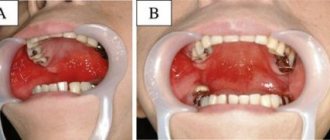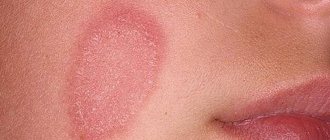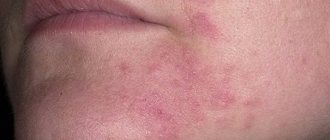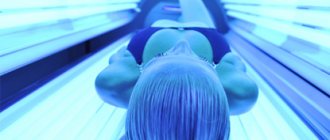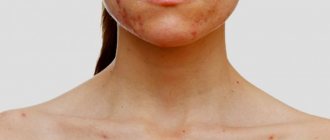Red spots on the neck may be evidence of illness, the body’s reaction to environmental factors, or the consequences of psychomotor disorders. Their appearance may be accompanied by itching and flaking. To make a correct diagnosis and find out the cause of the spots, it is recommended to consult a specialist and undergo a series of examinations.
It is prohibited to treat red spots on the neck at home, especially if they are filled with exudate and itchy. This is explained by the fact that such actions can lead to the formation of severe complications. Now we will try to figure out why red spots appear on the neck.
Etiology
If we talk about redness of the skin on the neck as a result of certain diseases, we should highlight the following:
- hyperthyroidism;
- allergic reactions;
- neurodermatitis;
- fungal diseases;
- psoriasis;
- atopic dermatitis.
In addition to pathological processes, external irritants can provoke redness on the neck of an adult or child:
- scratching insect bites;
- prolonged exposure to the sun;
- increased susceptibility to ultraviolet rays;
- reaction to metals or fabric;
- stress, nervous tension.
Redness on the neck of a baby may be a manifestation of hormonal changes, which is not a disease. In such cases, redness disappears on its own within the first month. In addition, such a manifestation may be a sign of food allergy or infection in newborns, so consultation with a doctor is required.
Even if red spots on the neck and back of the head do not cause concern, you should still seek the advice of a doctor and not self-medicate or completely ignore the symptom.
When to start worrying
Dry spots that appear on the skin and are accompanied by flaking and itching should be treated under the supervision of a specialist in the following cases:
- spots gradually occupy an increasing area of the skin;
- long-term treatment does not lead to positive results and the disappearance of spots, or the symptoms disappear, but reappear with the end of taking the medications;
- the appearance of spots is accompanied by pain or itching;
- wounds, ulcers or pimples appear around the pigments;
- pigmentation appeared in people living with the patient.
Important to remember! Identification of any of the described signs indicates the need to consult a qualified doctor to obtain an accurate diagnosis.
If you have a dry patch of skin that is flaky and itchy, do not put off visiting a dermatologist. It may turn out to be a disease.
Symptoms
The clinical picture will depend on the cause of this symptom. In case of an allergic reaction, redness may be accompanied by the following symptom complex:
- itching, which can occur both at rest and when scratching;
- rashes in the neck, back of the head, and sometimes back;
- general malaise;
- low-grade body temperature.
If the cause of this symptom is a fungal disease, then the clinical picture can be characterized as follows:
- in the area of redness, flaky spots may appear, with the formation of bubbles with liquid;
- severe itching and burning;
- spots can transform into plaques, papules, erosions;
- itching may be present not only in the area of redness, but also in other areas of the body.
Redness of the neck in men or women may be a manifestation of thyroid disease, which will be accompanied by the following symptoms:
- itching on the front of the neck;
- inflammation of the cervical and submandibular lymph nodes;
- tachycardia;
- shortness of breath, rapid breathing;
- increase in goiter;
- periodic increase in body temperature.
Redness on the neck may be a sign of neurodermatitis. In this case, the clinical picture will be characterized as follows:
- severe itching, which only intensifies when scratching;
- a rash that later forms into plaques and blisters with fluid;
- rashes can be grouped together;
- formation of crusts at the site of the rash.
For any type of manifestation of the clinical picture, you should seek help from a doctor rather than try to eliminate the symptom yourself. The use of local remedies can eliminate the symptoms, but not the provoking factor itself. This means that a relapse of the disease or the development of complications can occur at any time.
Factors provoking the disease
Rashes on the neck occur for a number of specific reasons.
The most common causes of allergic symptoms are the following factors:
- use of low-quality cosmetics;
- negative environmental situation;
- A rash on the neck and chest may appear (especially in women) upon contact with jewelry made from precious or simple metals. In this case, redness of the skin is caused by prolonged wearing of jewelry, when, when interacting with the body, the metal undergoes oxidation processes. In this regard, severe itching and a small rash appear;
- use of medicated gel and ointment in the cervical area;
- violation of the diet (especially in a child), expressed by the consumption of highly allergenic foods, as well as the presence of chemicals in them (dyes, preservatives);
- allergies on the neck and chest can occur as a result of exposure to washing powders. Washed items (especially underwear) come into direct contact with the delicate areas of the skin on the neck, provoking an acute allergic reaction;
- the causes of allergic rashes in infants may be a complication caused by indolent heat rash, since prolonged exposure to sweat results in itching and a small rash;
- in addition, an allergic reaction can occur to flowering plants and upon contact with animals;
- Especially often, irritation on the neck can occur in a child due to pet hair;
- the causes of rashes may depend on the individual reaction to synthetic fabrics in direct contact with the neck area (shirts, sweaters, scarves, etc.);
- A rash on the neck is possible as a result of exposure to pathogenic microorganisms and viruses.
The skin of infants is especially sensitive to allergies, since their neck is characterized by the formation of a skin fold, which, when the child overheats or as a result of exposure to sweat, leads to similar symptoms.
With local exposure in the neck and shoulders, the following manifestations are noted:
- redness of the skin, accompanied by swelling;
- pain symptom, burning sensation on the skin;
- rash on the neck and severe itching;
- the skin is dry and flaky;
- a small red rash may be accompanied by watery blisters that burst spontaneously;
- when allergic symptoms appear systemically, pain in the shoulders and head may occur;
- the child experiences severe itching, the neck itches unbearably and the baby may become restless;
- difficulty breathing in the chest may be present;
- impaired visual perception, allergic rhinitis.
A red rash, itching and spots that appear on a child’s neck, in addition to an allergic nature, may indicate vegetative-vascular disorders, lichen, atopic dermatitis, hemangiomas, various infections, etc. Therefore, first of all, it is important to find out the etiology of the disease.
Diagnostics
In this case, you should first contact a dermatologist. If a clinical manifestation of this nature is observed in a child, you should contact a pediatrician. In addition, you may need to consult an endocrinologist and immunologist.
Diagnostic measures may include the following:
- general blood and urine analysis;
- scraping from the affected area of the body for microscopic examination;
- hormonal studies;
- Ultrasound of the thyroid gland.
Based on the results of the study, the doctor can determine the etiology of the symptom and prescribe the correct treatment.
Treatment
Therapeutic measures will depend on the disease provoking this symptom. Drug treatment may include:
- antiallergic;
- sedatives;
- antifungal;
- antibiotics;
- histamine blockers;
- anti-inflammatory.
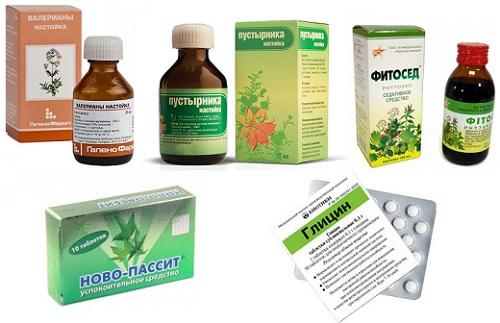
In addition, a diet may be prescribed, excluding allergenic foods.
To relieve acute symptoms, you can also use traditional medicine, but only after consultation with your doctor. In this case, it is advisable to use lotions from decoctions of the following herbs:
- series;
- chamomile;
- calendula.
During the treatment period, it is advisable to exclude spicy, salty, fatty foods and alcoholic drinks from the diet. The exact list of prohibited and permitted food products is determined by the attending physician.
Preventive actions
Proper nutrition and a healthy lifestyle are important steps to maintain youthful and beautiful skin and avoid diseases:
- Include foods rich in niacin in your diet: brewer's yeast, nuts, rose hips, liver, fish, milk, eggs.
- Let fresh parsley and celery be a constant green addition to your dishes.
- Vitamins A and E are found in vegetables and fruits with yellow, orange and red colors.
- Avoid sweet soda, fatty and spicy foods.
- Do not aggravate dry skin by frequent visits to the solarium.
The smoothness of the skin is maintained by scrubbing. You can make a scrub from sea salt or coffee grounds, or purchase a ready-made cosmetic product. Masks and creams will help remove peeling.
https://youtu.be/ibU0KXxCTsE
Prevention
There are no specific preventive measures, however, if you follow these recommendations, you can reduce the risk of such a symptom:
- maintaining personal hygiene;
- using only proven cosmetic products;
- timely treatment of all infectious, fungal, dermatological diseases.
In addition, you need to systematically undergo a medical examination to prevent illness or timely diagnosis.
Redness in the décolleté area worries many. There is no subcutaneous fatty tissue in this area, the skin is thin and delicate, easily reacting to any impact. Rashes in the form of red spots of different sizes often appear on it. A defect can be caused by many reasons.
Poikiloderma Siwatt
Dermatological disease of unknown etiology. It can be triggered by exposure to ultraviolet radiation, contact with coal and petroleum products, vitamin deficiency, wearing chains and other jewelry made of nickel. In addition to the chest, symptoms appear on the face, neck, shoulders and arms. First, reddish or brownish-yellow spots are formed, which gradually increase in size and merge with each other, forming a mesh pattern. Rashes in the form of nodules sometimes appear on pigmented areas. In some places the skin atrophies. Symptomatic treatment is indicated for patients. Topical steroid ointments are applied to the affected areas. Pigmentation is removed using a laser. It is useful to take a course of vitamins B and C.
Demodicosis
A parasitic skin disease caused by a microscopic mite. The pathology usually affects the face, but often the first symptoms appear on the chest. Insects settle in sweat and sebaceous glands, hair follicles. Their waste products cause vasodilation, acne and redness of the skin in the décolleté area. When the rashes go away, scars remain in their place. For treatment, external disinfectants and anti-inflammatory agents are used. In difficult cases, antibiotics are prescribed. It is necessary to strengthen the immune system and thoroughly cleanse from sweat and sebum.
Lichen
There are several varieties of this disease. Most often, the cause of pathology is pathogenic fungi. They provoke peeling, the appearance of multi-colored spots, and various rashes. In some cases, the affected areas become wet and inflamed. The process is accompanied by severe itching. Therapy involves the use of antifungal agents for internal and external use. The lesions are also treated with anti-inflammatory and drying ointments. Ultraviolet light has a beneficial effect. Additionally, vitamins and immunomodulators are prescribed.
Ichthyosis and peeling skin on the neck
Ichthyosis is a hereditary disease that is caused by gene mutation . The affected areas of the skin are very flaky and resemble fish scales in shape. Ichthyosis can be mild, when the skin has a slight roughness, or severe, where keratinization of the epidermis occurs.
The skin with this disease is so dry that it can crack. The cracks subsequently become wet and very painful. In this case, there is a risk of infections getting into them and worsening the patient’s condition.
Mastitis
Usually appears in nursing mothers due to stagnation of breast milk. The gland thickens, the skin over it turns red and becomes hot to the touch. Pain occurs. Sometimes the problem disappears on its own if you put your baby to the breast more often or use a breast pump. If stagnation is not eliminated, the situation gets worse. Pus appears in the milk, and the pain intensifies. In this case, treatment includes taking antibiotics and novocaine blockades. It may be necessary to open the abscess and drain its contents.
If the décolleté area turns red, it is important to promptly identify the cause of the problem. Even relatively safe conditions can lead to serious complications if left untreated. The only exception is redness due to nervousness, but even in this case, the help of a neurologist may be needed.
When the neck itches and there is redness, this can indicate both an allergy and manifestations of a dermatological disease. Both are extremely unpleasant. These symptoms have a serious impact on the psyche and emotional state. With severe itching, sleep disturbance occurs, the person becomes irritable and joyless. To avoid rashes in the neck area, you need to know the cause of their origin. In this article we will look at why a rash appears and what to do when it appears.
What can cause itching?
The most common factors influencing the formation of itching in the neck area are:
- allergy;
- infection;
- scabies;
- mycosis.
One of the reasons why the neck turns red and itches is fungal infections. They manifest themselves as small merging spots, itching and peeling. These diseases are caused by yeast-like fungi. At first the spots are yellow, but over time they become dark red. This pathology is called pityriasis versicolor.
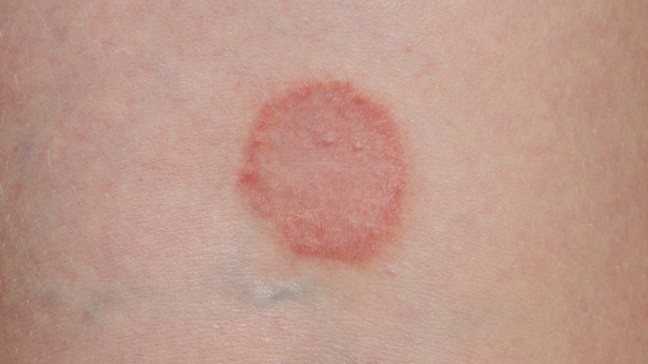
Ringworm can also cause a rash on the neck that itches. Its causative agents are microsporum and trichophyton fungi. The disease most often affects the scalp. The advanced form of the disease can spread to the face, neck and chest. In these areas, round spots with a clear red outline appear.
This disease is chronic. It manifests itself as inflamed areas and peeling. Psoriasis differs from other pathologies in teardrop-shaped or oval spots, which have a light grayish surface. These plaques protrude on the surface of the skin and are very itchy. The spots are localized on the shoulders, back and neck. Psoriasis is difficult to treat. Therapy takes from six months to two years.

When the thyroid gland malfunctions, active production of hormones begins: thyroxine and triiodothyronine. This disorder is called hyperthyroidism. With this disease, a person’s weight increases, metabolic disorders occur, and mood swings are observed. In severe cases of the disease, problems with the heart and reproductive system may occur. With hyperthyroidism, there is itching in the anterior neck, tachycardia, bulging eyes, enlarged goiter, and increased body temperature. If itching accompanies at least one of the symptoms, you should urgently consult an endocrinologist.
It manifests itself as red spots on the neck that are quite itchy. It is found on closed areas of the skin, under clothing. The disease should not be neglected, as it is quite difficult to treat.
With this type of disease, red spots with a rough surface appear. They are localized in the cervical-collar area. Additionally, atopic dermatitis manifests itself as cracks around the lips or earlobe.
Men and women love to decorate themselves with various accessories. Some jewelry is of low quality. When metal comes into contact with the skin, it causes a negative reaction. It manifests itself as itching and redness of the neck and décolleté.

Sometimes jewelry made of precious metals can also trigger a rash. Due to the fact that they have not been cleaned for a long time, the top layer oxidizes and causes irritation. To prevent this from happening, all gold and silver products must be regularly cleaned in a special chemical solution.
An itchy neck can also be caused by insects. This could be a bite from fleas, bedbugs, mosquitoes, or lice. When bitten by a demodex mite, demodicosis occurs. This type of mite lives in hair follicles and sebaceous glands. Their activity can be caused by stress, decreased immunity and other reasons. After its bite, rashes appear on the neck of an adult. They can fester and become very itchy.
Sometimes red spots on the neck and face may appear due to infections. This includes chickenpox, lichen, candidiasis.
Neck allergies can be caused by severe emotional shock or insufficient fluid intake. In rare cases, it speaks of serious diseases, such as kidney failure, blockage of the bile ducts.
The body can also react negatively to laundry detergent. It contains harmful substances that, when they come into contact with the skin, cause rashes, redness and itching. Allergies can be caused by changing eau de toilette, deodorant, or body lotion.
A red spot on the neck that itches can be a sign of psoriasis and eczema. During these diseases, in addition to itching, peeling is observed.

Signs of manifestation
If the allergy manifests itself from local exposure to the neck area, the following symptoms will be noticeable:
- swelling, redness of the skin;
- pain, burning sensation;
- itchy neck;
- dryness and flaking;
- spots, small bubbles, scales.
Then, when an allergic reaction in the neck is part of a systemic reaction, the following symptoms may be added to the above listed:
- headache;
- difficulty breathing;
- swelling of the mucous membranes;
- deterioration of hearing and vision.
The appearance of red spots on the neck is not only due to allergies, they can be the result of autonomic disorders, lichen, atopic dermatitis, insect bites, other skin diseases, hemangioma, infectious diseases, irritations due to sensitive skin, scleroderma. If a person has been under stress for a long time, or has been subjected to overheating, nervous and physical stress, he may develop red spots on his neck. They will indicate that autonomic disorders have occurred and vascular tone has been impaired. This disease most often does not cause any discomfort or pain. You can eliminate it by following the correct daily routine, doing physical exercises, and taking a contrast shower.
Flaky spots on the neck may also indicate that a yeast-like fungus has entered the human body.
In a patient with lichen, spots appear on the neck, shoulders, and chest. Under the influence of ultraviolet radiation they become brownish, gradually dry out and disappear. Lichen is treated with Lamisil and Clotrimazole.
Pityriasis rosea, which affects people with weakened immune systems, appears gradually. Just 1 spot, then other smaller ones form around it. They are red in color and may be yellow in the middle. Most often, this type of lichen does not require any special treatment. After 2-3 weeks it goes away on its own.
If a person is sick with vegetative-vascular dystonia, red spots may appear due to great emotional upheaval and consumption of large amounts of alcoholic beverages. Atopic dermatitis also causes spots on the neck, which can later cause significant discomfort because they are very itchy. To eliminate these negative symptoms, doctors recommend using various cooling ointments and antipruritic drugs.
Spots on the neck may appear due to other diseases (eczema or psoriasis). The damaged areas are also very itchy and a burning sensation is felt. To recover, you should use hormonal ointments. Spots of a dark burgundy color, small in size and similar to moles are hemangiomas, which are benign formations on human skin. As soon as such spots begin to increase in size, you should consult a doctor. Eczema is called a childhood disease because most cases occur in children, but there are cases of the disease in adults as well.
Based on the age of the patient, eczema is classified into 3 groups:
- Infant. Occurs between the ages of 2 months and six months, most often in infants who are fed artificial formula. Symptoms of the disease are a rash that immediately appears on the face, then on the torso, and limbs. Its color is red, almost invisible at once. But then it becomes more intense, which indicates that the disease has entered a more progressive stage. the child will want to scratch his face so that the itching will not be as strong. Many children who become ill at this age finally recover from the disease after a few years.
- Children's room. Begins to develop at the age of 1.5 years or more. The most vulnerable areas of the body are the wrists, the skin on the elbows and under the knees, the outer surface of the hand and fingers. A child who suffers from eczema is very nervous and irritated due to constant itching. Sometimes children cannot stand the intense itching and scratch their skin until it bleeds. The skin of children who suffer from eczema for a long time becomes very dry and cracked.
- An adult. Despite the fact that eczema is a childhood disease, it also occurs in adults. In an adult, eczema mainly affects the head, the area around the mouth, eyelids, wrists, skin under the knees, and on the bends of the elbows. The affected skin is dry, rough, and in some places there are small blisters. There are situations when the disease does not make itself felt for years, and then manifests itself with renewed vigor. Such manifestations are often associated with stress and strong emotional upheaval.
The causes of eczema are considered to be:
- according to the first version, a high concentration of eosinophils;
- the second is contact of the affected skin with any allergen (dust, pet hair).
It is generally accepted that food products consumed by adults and children contribute to the exacerbation of the disease. When we talk about infants, the reaction to drinking cow's milk is of great importance. Eggs can cause disease or provoke its exacerbation. Therefore, it would be advisable to use a special diet for such children, which will include only hypoallergenic foods. The diet should also be followed by mothers who are breastfeeding. After all, many foods can affect the development of an allergic reaction - cheese, citrus fruits, nuts, spices, alcoholic drinks.
Factors that may influence the exacerbation of the disease include:
- chemicals that are part of household chemicals (detergents, washing powders, soaps, shampoos, cosmetic creams, lotions).
- nervous overstrain (can be both a cause and a consequence of the disease).
- clothing (woolen and nylon fabrics can cause skin irritation and contribute to the appearance of eczema; clothing with hard and rough edges also irritates the patient’s skin, so loose cotton clothing would be the best option).
- diet (since many food products are allergens that can cause the development of skin diseases, the patient needs to adjust his menu. Remove the most likely allergens from it - milk, eggs, chicken, citrus fruits. If after this a positive effect becomes noticeable, then follow the diet in the future will contribute to a person’s well-being).
- The time of year affects the exacerbation of diseases. Most often they get sick in cold weather.
- other allergens, which include house dust mites and animal hair, can also cause negative reactions in the body.
- infections. Various infections on the skin, which are accompanied by a cough and runny nose, can trigger the appearance of eczema, especially in childhood.
Spots on the neck may be the result of insect bites (midges or mosquitoes). Due to severe itching, a person begins to scratch intensely, which can cause spots to appear. To prevent the bites from itching too much, they are treated with special ointments.
Spots on the skin can also occur due to its increased sensitivity. They can become inflamed, itchy and itchy. To minimize the negative effects of sweat, it is worth using an antiseptic cream. Such a serious disease as vitreous derma is characterized by damage to connective tissue. They manifest themselves in two forms: limited and widespread. The common form is characterized by almost complete damage to organs and organ systems, and the limited form is characterized by certain areas of the skin.
Scleroderma is accompanied by the appearance of such symptoms as:
- the appearance of red spots;
- swelling;
- the appearance of plaques that become hard, keratinized areas.
Basic therapy methods
Hives on the neck are treated with medications and folk remedies. In this case, you should not self-medicate. Any medications should be taken under medical supervision.
If redness in the neck is caused by nervous tension, take valerian infusion, motherwort herb, Tenoten, Afobazol, Novopassit, Persen. Itchy pimples can be lubricated with ointments and gels that contain an antibiotic. They dry out the rash on the face and neck, relieve inflammation, and destroy bacterial flora.
When the itching is allergic in nature, histamine blockers are prescribed. They reduce the production of this hormone, which, in turn, provokes the formation of allergy symptoms. When treating a red rash on the neck in an adult, the following are used: Loratadine, Diazodlin and Suprastin.
For demodicosis, emulsions Medifox and Benzyl benzoate, Wilkinson's ointment and sulfur ointment are prescribed. They treat only the affected areas. As the mites die, the intensity of the itching decreases. The neck completely stops itching after three uses.
Fungal infections, dermatitis, and infectious diseases are treated with medications. Only a doctor can prescribe the necessary medications. Self-medication in this case is contraindicated, since these medications have a large number of contraindications and side effects.
Immunostimulants are prescribed for psoriasis. This includes tinctures of Eleutherococcus and Echinatia, Lykopid tablets. For external use, ointments, gels and emulsions are prescribed.
The easiest way to relieve itching is to take a bath in cool water. An oatmeal bath will also help. To do this, you need to grind a glass of cereal using a coffee grinder and dissolve the resulting powder in water. The bath should be taken for at least 15 minutes.
You can use a baking powder mask. To prepare it you need to take 2 tablets of ascorbic acid, a few drops of water and a little baking powder. These ingredients must be mixed until smooth and applied to the affected area.
A decoction of medicinal herbs will help relieve itching and redness on the neck. It includes chamomile, calendula and string. Using a decoction you can relieve inflammation, irritation and itching. To do this, you need to wipe your neck three times a day with a moistened disc.
You can also rub your neck with olive oil and use moisturizers.
To avoid the appearance of a rash on the neck, you should not wear massive jewelry in the summer for more than 6 hours a day. All jewelry should be cleaned regularly with a special solution. This will remove any dirt or oil that may be causing irritation. Neglect of these simple rules explains why the back of the neck itches in hot weather.
If the neck constantly sweats, then it should be wiped with a dry soft cloth. In the summer, it is worth taking a shower daily.
Since it is impossible for men to give up shaving, to avoid minor rashes on the neck, you should purchase a high-quality razor with smooth shaving blades. It is also worth using special shaving products.
Clothes and linen should be washed using products that do not contain fragrances or fragrances. To clean it of all chemical compounds, you need to use an additional rinse.
When choosing clothes, give preference to natural materials. It is better to wear cotton; wool and polyester can irritate the skin. Make sure that your clothes do not have a too tight neckline.
And remember, if irritation does appear on your neck, do not scratch or scratch it! Even a small wound can open the door to infection.
A common complaint when visiting a dermatologist is various rashes on the body. They cause the greatest discomfort when localized in open areas of the body. Therefore, a pressing issue is the appearance of red spots on the neck, the cause of which many want to know.
Lichen planus: features and methods of treatment
The reason why red and itchy areas form on the neck may also be a type of lichen planus. It is characterized by the formation of richly colored plaques, with the affected areas enlarging and joining over time. Lichen planus appears in different areas of the body, but most often affects the following:
- inner sides of wrists, elbows, knees;
- neck;
- back.
In some cases, the disease spreads to the mucous membranes and groin, and is also accompanied by a change in the appearance of the nails: they become lumpy, with grooves and waves.
Complaints of lichen ruber occur in people between 30 and 70 years of age, and the causes remain unclear.
Thanks to the characteristic symptoms, dermatologists quickly diagnose the disease and, if necessary, perform a biopsy. Although doctors have not yet found ways to completely defeat this type of lichen, it will be possible to reduce the manifestations with the help of antihistamines.
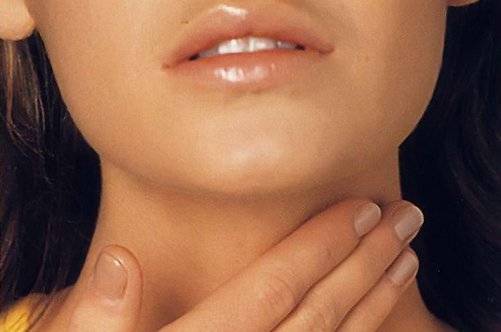
Home methods: how to alleviate the condition
Although treatment can only be selected with the help of a doctor, the discomfort caused by the neck in the affected areas can be alleviated. Use the following methods:
- A recent study published on the website of the US National Library of Medicine confirmed the effectiveness turmeric in the treatment of lichen planus. Dilute the powder with water to obtain a paste-like consistency and apply to the affected areas. Let it act for 10 minutes, rinse with water. You should not keep a turmeric mask on your skin for too long, otherwise your skin will turn yellow.
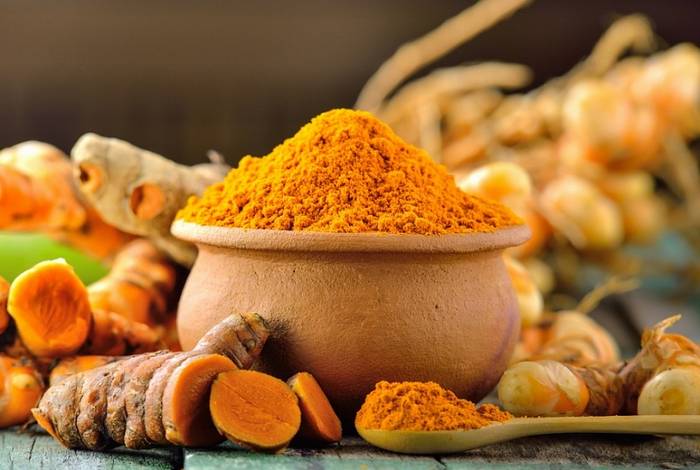
- Sage decoction taken internally will relieve itching and burning.
- Aloe vera can be used separately or mixed the juice obtained from one leaf with 1 tsp. honey Apply the product to your neck before going to bed and wrap it with a clean cloth: you will notice improvements in the morning.

- Oatmeal will help relieve redness and relieve itching. Fill them with hot water and let them brew. When the flakes swell, apply the mixture to your neck - the disturbing symptoms will quickly go away. Eating oatmeal will also relieve stress, which causes exacerbations of lichen red: doctors say that the flakes contain substances with a calming effect.
- Valerian tincture taken internally also relieves nervous tension.
Although home remedies are not a substitute for consulting a doctor, they can provide relief.
Why did they appear on the skin of an adult?
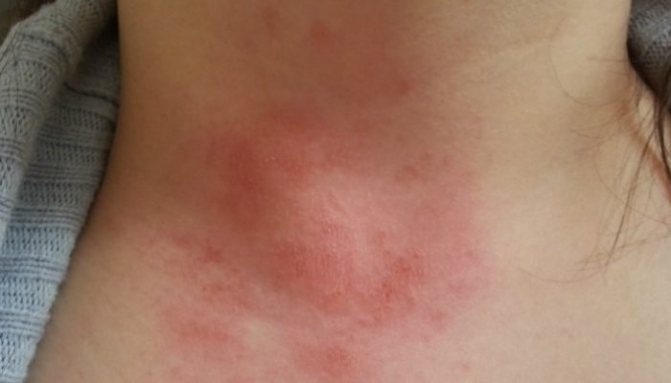
The origin of red spots in adults is very diverse. Throughout life, people have to deal with a lot of external irritants and health problems that affect the condition of their skin. If the skin turns red or small spots appear on the neck, all this should be a signal to seek medical help.
When sebum secretion is disrupted and its composition changes in the head, face and neck, seborrhea develops. The disease, which is becoming a widespread problem in dermatology, has several varieties:
- Fat.
- Dry.
- Mixed.
The first is characterized by increased sebum secretion, the second by decreased, and the third form combines the features of the previous ones. Seborrhea occurs under the influence of hormonal changes during puberty, poor nutrition, stress factors, and endocrine pathology. Its symptoms will be the following:
- Oily shine.
- Peeling.
- Skin itching.
- Hair loss.
- Dandruff.
Sebum becomes a breeding ground for fungi, which settle in the mouths of hair follicles, causing irritation and inflammation with the development of dermatitis. With seborrheic dermatitis, involvement in the process of the behind-the-ear areas, scalp, eyebrows, beard and mustache is observed, where erythematous-flaky itchy lesions (spots, papules, plaques) are formed.
Red itchy spots on the scalp and back of the neck may be a symptom of seborrheic dermatitis, which occurs due to a violation of the production of sebaceous secretions.

There are clear gender differences in some conditions. In women, red spots on the neck and face may indicate allergies to cosmetics, irritation from scarves or long collars made of synthetic fabrics. But there are other reasons for what is happening:
- Rosacea (rosacea).
- Lupus erythematosus.
- Menopausal syndrome.
Rosacea is usually experienced by women over 40 years of age, as well as those who have arterial hypertension and gastrointestinal diseases. First, a slight erythema appears, which intensifies with the consumption of spicy foods and alcohol. Then it takes on a stagnant bluish-purple hue, accompanied by the formation of nodules.
Red spots on the face and neck are a common sign of menopausal syndrome, which occurs due to hormonal imbalance (estrogen deficiency) in women over 45 years of age. The symptom is part of the structure of neurovegetative disorders, which also include:
To one degree or another, neurotic disorders are always present - irritability, tearfulness, drowsiness, feelings of fear and anxiety, depression. In addition, there is dry skin and mucous membranes, an increase in the number and depth of wrinkles, itching in the external genital area, and increased urination. These symptoms cause a lot of discomfort and interfere with everyday life.
Sometimes women are more likely to develop red spots on the neck, which provokes emotional disorders in them due to a defect in appearance.
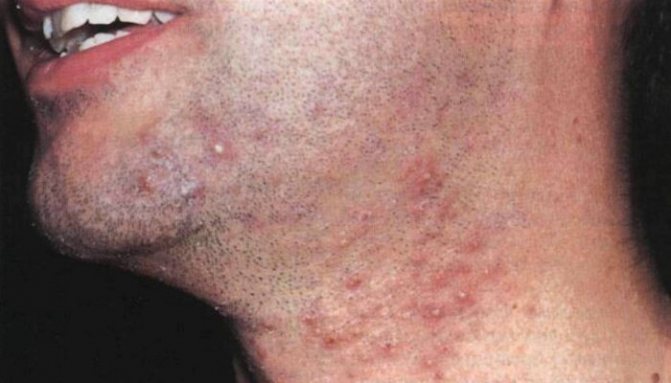
Redness on the neck in men may be due to skin irritation after shaving, intolerance to lotions or balms. In this area, purulent-inflammatory processes described as pyoderma may occur. Usually men are faced with two of its varieties - sycosis and boil. Factors in their development include trauma, maceration and skin contamination, chronic diseases (diabetes mellitus, obesity).
Starting in the beard area, small ostiofolliculitis and folliculitis gradually merge with each other and spread to neighboring areas. An inflammatory infiltrate forms around them, the individual elements merge with each other into a continuous bluish-red surface with a conglomerate of pustules. After opening the latter and draining the pus, dirty yellow crusts form. The disease lasts a long time and often recurs.
One of the common pustular diseases is a boil, which occurs on unchanged skin or complicates the course of other types of pyoderma. In men, it can occur due to frequent friction with a tight collar or tie with further penetration of pathogenic flora (usually staphylococci) into the damaged area. In its development, the boil goes through several stages:
- Infiltration.
- Suppuration and necrosis.
- Healing.
First, a bright red, painful infiltrate appears around the hair follicle, gradually becoming cone-shaped. The skin over it is tense, the local temperature is increased. When suppuration occurs, a pustule forms in the center, local symptoms intensify, fever and headaches are noted. When opened, green pus with a necrotic core leaves the boil; after cleansing, the wound heals with scarring.
Red, painful lesions in men occur with purulent-inflammatory pathology with damage to the hair follicles.
Red spots on the neck can manifest various dermatoses, in the development of which toxic and infectious-allergic reactions and immunopathological changes play a role. Among them, the most common conditions are:
- Neurodermatitis.
- Toxidermy.
- Psoriasis.
- Pityriasis rosea.
Atopic dermatitis (neurodermatitis) begins with noticeable itching. Then erythematous spots with papules, infiltration, peeling, and emphasized patterns (lichenification) appear on the skin. White dermographism is characteristic; itching provokes scratching and neurotic disorders (insomnia, irritability, decreased mood).
Toxidermia usually occurs in response to the administration of various drugs (antibiotics, NSAIDs, sulfonamides, vitamins), and is accompanied by the appearance of bright red dotted or larger spots on the body and face, which can merge until erythroderma occurs. The color may fade in the center of the elements, causing them to appear as spots with a smooth or flaky surface. Itching of varying intensity occurs, often accompanied by lacrimation, dyspeptic disorders, and low-grade fever.
Skin lesions due to psoriasis can affect any area of the skin, including the scalp. First, a small pink-red papule appears - flat, covered with small scales, round in shape. Further, the rashes increase in size and merge into plaques that take on bizarre shapes. Against this background, itching and a feeling of tightness of the skin may occur.
The primary focus of pityriasis rosea may occur in the neck and upper chest area. It looks like a swollen oval or round pink-red spot with clear boundaries. The shape of the maternal plaque resembles a medallion, and its surface resembles crumpled tissue paper. Soon similar but smaller elements spread throughout the body (except for the face and lower extremities). In adults, pityriasis rosea is sometimes accompanied by itching or burning.
A red rash in the form of papules or plaques occurs in many recurrent dermatoses.
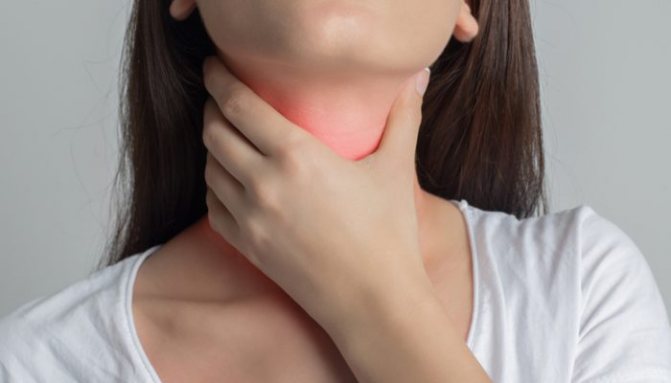
Redness of the skin on the front surface of the neck occurs with acute inflammation of the thyroid gland. Thyroiditis occurs when infection occurs from surrounding tissues or through the bloodstream. Among the local signs, not only redness is noted, but also an increase in the size of the gland, its pain on palpation, a reaction from the regional lymph nodes, and an abscess is formed during a purulent process. The patient’s general well-being also suffers – fever with chills, malaise. Thyroid function is usually not affected.
Rough skin
Rough skin is a condition of the surface epidermis caused by disturbances in the functioning of the hydrolipid film (the uppermost protective layer of the skin). Malfunctions in its operation can occur either under the influence of natural factors (aging of the body, weather and living conditions, improper care of the skin of the face, hands or body, etc.), or arise as a symptom of serious diseases of the body (dermatological, hormonal, hereditary) , nervous, etc.).
Externally, roughness of the skin is expressed in its loss of elasticity and moisture. It becomes thickened, can change its natural color (redden, turn purple, turn blue, turn pale), plaques can form on its surface, scales can accumulate, rashes, blisters, and maceration may appear. Areas with a rough surface feel like sand and are rougher and drier than healthy skin.
Natural factors that cause rough skin include:
- prolonged exposure to high or low air temperatures (overheating, hypothermia), sunlight, wind, sea water;
- professional activities associated with hazardous industries or the use of various types of chemicals (found among people employed in the oil or coal industry, medicine or pharmacology, in household chemical production, when working in conditions of high radiation);
- use of inappropriate skin care products or neglect of body hygiene (long-term lack of water procedures, etc.);
- poor nutrition with a deficiency of proteins and vitamins, fasting, strict diets or, conversely, constant overeating, abuse of fatty, salty or smoked foods;
- bad habits (tobacco smoking, alcoholism, drug addiction);
- frequent use of household chemicals in everyday life;
- puberty, menopause, aging.
Among the reasons that cause this phenomenon as a result of the development of diseases of the body, we can highlight:
- high sensitivity of people to external irritants (the occurrence of allergic reactions);
- skin (dermatitis, psoriasis, eczema, furunculosis) and venereal (syphilis) diseases;
- metabolic diseases (diabetes mellitus, obesity) and hormonal diseases (thyrotoxicosis, epidemic goiter, diabetes insipidus);
- hereditary autoimmune diseases (vasculitis, scleroderma);
- pathologies of the gastrointestinal tract;
- neuroses (psychoses).
Reasons for a child
Children are no less susceptible to the formation of red spots on the neck than adults, but in them the structure of probable conditions seems to be somewhat different due to the anatomical and physiological characteristics of the body and the action of external factors.
With prolonged contact of the baby's delicate skin with sweat, irritation first develops, but then an inflammatory process joins it. This is provoked by too warm wrapping and high room temperature. Miliaria usually affects the neck, back, and large folds. The first symptoms are a feeling of itching and slight redness, then small grouped or scattered vesicular elements appear, filled with transparent contents.
This is how the mildest – crystalline – form of prickly heat manifests itself. The only difference between the red one is the appearance of an inflammatory rim along the periphery of the elements, while the papular one is characterized by a deeper lesion. The contents of the bubbles then become cloudy, they merge with each other, and in advanced cases, weeping lesions form in the folds of the skin.
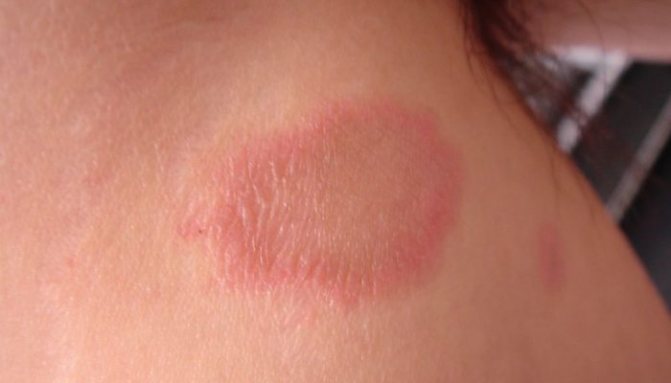
If your child's skin is covered with red, scaly spots, you should think about ringworm or microsporia. This is a fungal disease that is contracted through infected things and through contact with pets (cats, dogs). The pathology affects smooth skin and scalp.
With microsporia, red, scaly spots with clear outlines and raised edges appear in the neck, back or chest. Papules, blisters, and crusts can be seen along the periphery. The central part of the lesions is less colored and sinks, so they often take on a ring shape. Similar changes are observed on the head; a characteristic sign is hair breaking off at one level.
Microsporia often affects children attending preschool institutions, where the infection is quickly transmitted within the community.
In infants and young children, one of the most common dermatoses is eczema. The development of the disease is associated with an allergic predisposition, dietary errors (artificial feeding), and imperfections in the enzyme systems of the digestive tract.
The rash is first localized on the face and scalp, then spreads to other parts of the body. They are characterized by evolutionary polymorphism:
In children, the phenomena of exudation and allergization are quite pronounced. The rashes are abundant, tend to merge, and due to the addition of secondary microbial flora, they are often complicated by streptoderma (impetigo).
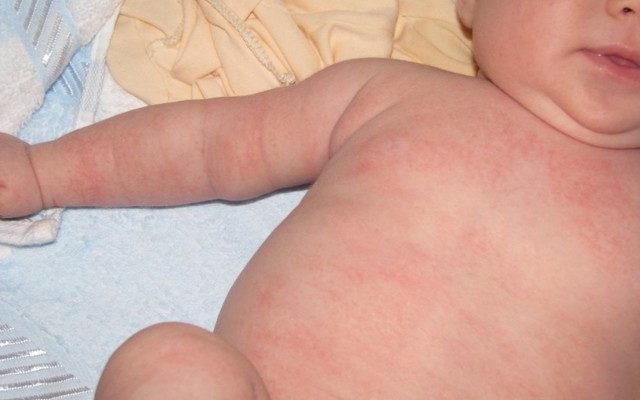
Red rashes on the neck can be infectious in nature, occurring as a result of various childhood diseases:
- Corey.
- Rubella.
- Scarlet fever.
- Erythema infectiosum.
Skin manifestations depend on the nature of the pathology. Measles and erythema are accompanied by a maculopapular rash on the face, trunk, limbs, rubella is small-spotted with a concentration on the extensor surfaces, and with scarlet fever, point elements appear, densely scattered in natural folds. The period of rashes is preceded by catarrhal symptoms and occurs against the background of a deterioration in the general condition.
A rash on a child’s body may be a sign of infectious diseases of viral or bacterial origin.
What are they?
Depending on the cause, acne may look different. By appearance, one or another violation can be assumed.
- Red rashes often merge into large lumpy spots. They are accompanied by inflammation, itching, burning and pain. You can meet them with allergies and thermoregulation disorders.
- White small tubercles develop without an inflammatory process. These are called closed comedones. The rashes are caused by improper care and blockage of the sebaceous ducts.
- Purulent formations appear when bacteria penetrate. They are formed in case of hormonal problems, diseases of the endocrine system.
- The appearance of subcutaneous acne indicates a decrease in immune defense and improper care. In addition, rashes may indicate that demodex mites have penetrated the skin.






